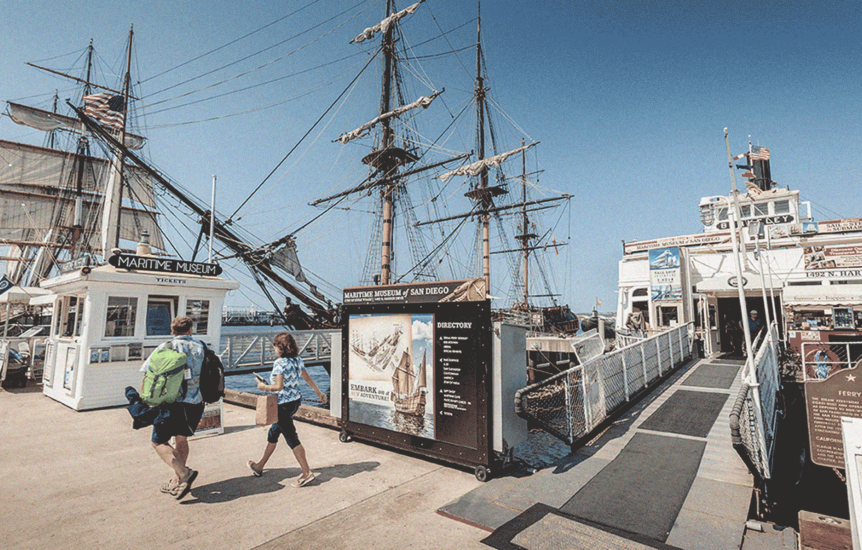Climb Aboard Six Centuries of Maritime History

From the world’s deepest diving submarine to the first steam-powered vessels, the Maritime Museum’s flotilla is sure to impress even the most experienced seafarer.
Listen to the history of this landmark in the HearHere App — 🔊 The Maritime Museum of San Diego
Founded in 1948, the Maritime Museum of San Diego hosts one of the world’s finest collections of historic and replica vessels. Today the museum is home to five centuries of seafaring history gathered into a story as alive and active as the ocean’s winds and currents. Nothing compares to stepping on board these wonderful vessels, and experiencing first hand their unique identities and fascinating exhibits.
Here at the dock floats the story of nautical technology, told through a variety of vessels each representing an era in maritime history and culture: the Star of India – one of the last surviving examples of the oceanic sailing ship from the great Age of Sail; the steam ferry Berkeley that transported commuters across San Francisco Bay for decades. Contained within these ships is a unique series of exhibits containing the museum’s collections of maritime artifacts, ship models, photography and fine art. The dialogue between ship and artifacts tells compelling stories of the evolution of maritime technologies, exploration, naval warfare, fishing, and immigration.
One of the first ships you’ll notice on your tour is both the newest and “oldest” ship in the collection, the San Salvador. San Salvador is a replica, just launched in 2015, of the Spanish galleon that arrived at this magnificent harbor in 1542—just 50 years after Columbus first sighted the New World. The Maritime Museum of San Diego led the building of that replica only a few miles away from the Museum, with support of the community, hundreds of volunteers and generous donors. She is as close as you can come today to how a 16th Century Spanish galleon looked, sailed, and handled. What we would describe as a small, fragile ship nevertheless transported its adventurous crew on a journey to shores never before seen by Europeans. The maritime technologies used in the construction and sailing of the original San Salvador were the result of centuries of experience, innovation and development.
Today, far from being a static exhibit, San Salvador sails regularly on San Diego Bay and beyond. Crewed by highly trained professional captains and volunteers trained at the Maritime Museum, she offers visitors the opportunity for adventure day sails and private charters. Pacific Heritage Tours sponsored by the Museum along the California & Mexican coasts also offer passengers a chance to step back in time, learning to sail alongside Museum staff, and to experience the sights and sounds that would have been familiar to San Salvador’s original voyagers.
From the San Salvador visitors fast-forward to the late nineteenth century when they step on board the Star of India — 🔊 The Oldest Active Sailing Ship in the World. With her iron hull constructed in 1863, she remains a superb example of maritime innovation. Ironically she also represents one of the last generations of vessels produced for commercial purposes yet powered solely by the wind. You can see how quickly maritime technology changed by visiting the elegant ferryboat Berkeley. Constructed just under four decades after the Star of India, she boasts a triple-expansion steam engine and boiler room.
🔊 1898 Steam Ferry Berkeley. She is a California State Historic Landmark and a National Historic Landmark. She represents an extraordinary advance in maritime technology. In the 18th century, Scottish inventor James Watt developed a new source of power that would eventually make wind-powered vessels obsolete. Steam engines would eventually come to revolutionize transportation, making us no longer dependent on wind, water, and muscle alone. It was the beginning of the Age of Engines—in which we are now living. Once an engine could turn a wheel, it could drive a train—or a car—across a continent. Turning a paddle-wheel, or a propeller, it could drive a ship around the world. Square-rigged sailing ships couldn’t sail directly into the wind. The new steamers, like Berkeley, however, didn’t care where the wind was—it could drive right into it. And that was the end of the Age of Sail.
Another stop on your museum tour would be the USS Dolphin, the world’s deepest diving submarine. Nested right next to the sub, you will find the PCF 816 Swift boat, listed in the national register of Historic Places. If she is not docked at the Museum she is most likely off for naval history bay tours guided by Naval Veterans and passionate volunteers. You may also notice the Museum’s topsail schooner, and California’s official tall ship, Californian, a replica of the Gold Rush-era revenue cutter dockside or sailing through San Diego Bay. She is a highly popular among thousands of school groups and visitors, and an ideal platform school and youth group educational adventures and private charters.
The museum works year-round to restore, maintain, and preserve this historic fleet with support from visitors and donors alike. Be sure to get your ticket to learn even more about this amazing collection when you visit, open 10am-5pm daily. You can purchase online or at the door, with discounts for seniors, students, and members of the military.
Check out the historic Maritime Museum of San Diego here.
If you enjoyed these stories, and are ready for thousands more across the US, download the HearHere iOS App today.
